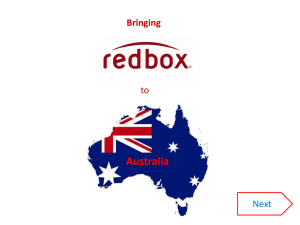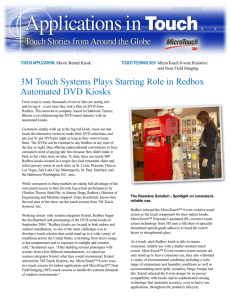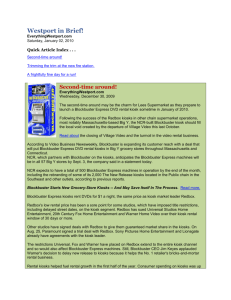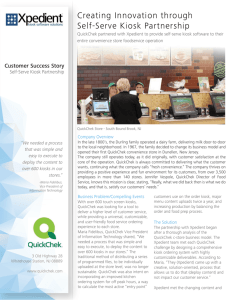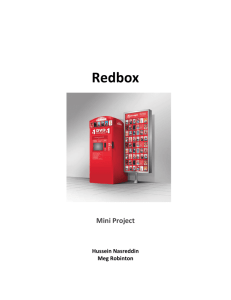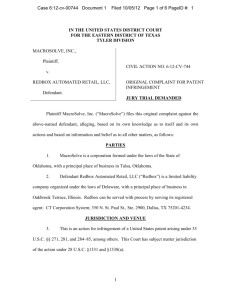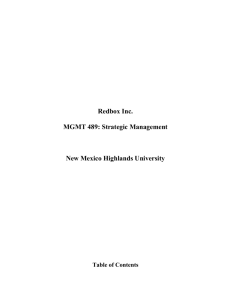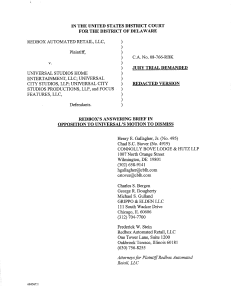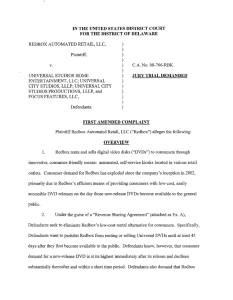Red Hot Rentals - jerrysoverinsky.com
advertisement
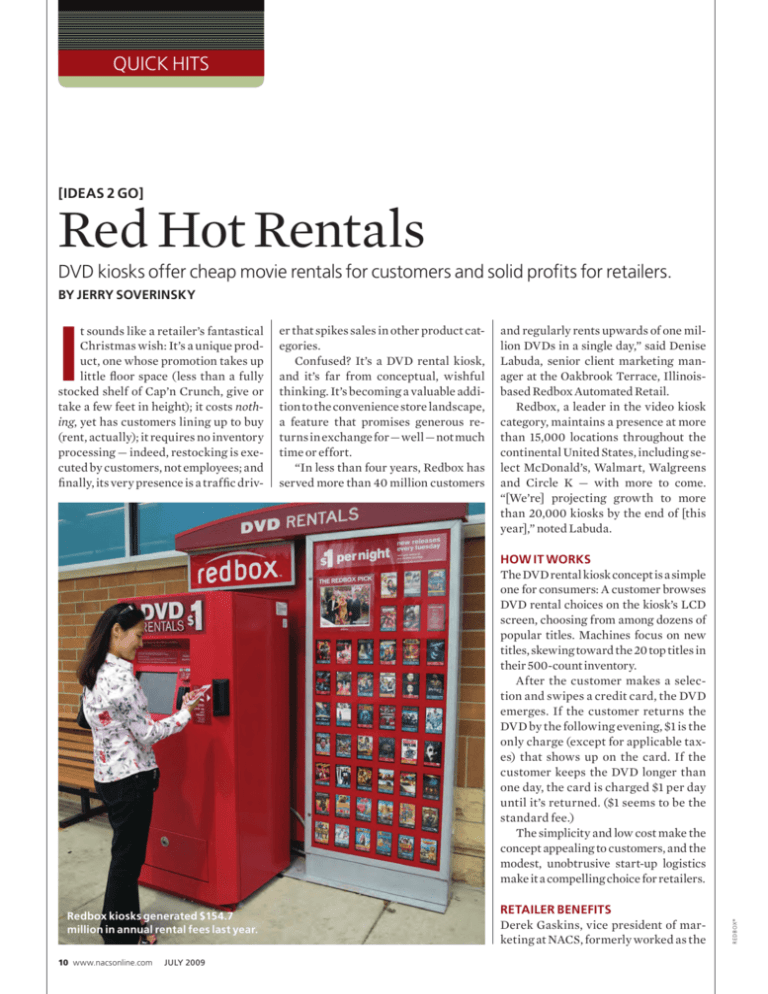
quick hits [ideas 2 go] Red Hot Rentals DVD kiosks offer cheap movie rentals for customers and solid profits for retailers. by jerry soverinsky I t sounds like a retailer’s fantastical Christmas wish: It’s a unique product, one whose promotion takes up little floor space (less than a fully stocked shelf of Cap’n Crunch, give or take a few feet in height); it costs nothing, yet has customers lining up to buy (rent, actually); it requires no inventory processing — indeed, restocking is executed by customers, not employees; and finally, its very presence is a traffic driv- er that spikes sales in other product categories. Confused? It’s a DVD rental kiosk, and it’s far from conceptual, wishful thinking. It’s becoming a valuable addition to the convenience store landscape, a feature that promises generous returns in exchange for — well — not much time or effort. “In less than four years, Redbox has served more than 40 million customers and regularly rents upwards of one million DVDs in a single day,” said Denise Labuda, senior client marketing manager at the Oakbrook Terrace, Illinoisbased Redbox Automated Retail. Redbox, a leader in the video kiosk category, maintains a presence at more than 15,000 locations throughout the continental United States, including select McDonald’s, Walmart, Walgreens and Circle K — with more to come. “[We’re] projecting growth to more than 20,000 kiosks by the end of [this year],” noted Labuda. Redbox kiosks generated $154.7 million in annual rental fees last year. 10 www.nacsonline.com july 2009 retailer benefits Derek Gaskins, vice president of marketing at NACS, formerly worked as the r ed box ® How It Works The DVD rental kiosk concept is a simple one for consumers: A customer browses DVD rental choices on the kiosk’s LCD screen, choosing from among dozens of popular titles. Machines focus on new titles, skewing toward the 20 top titles in their 500-count inventory. After the customer makes a selection and swipes a credit card, the DVD emerges. If the customer returns the DVD by the following evening, $1 is the only charge (except for applicable taxes) that shows up on the card. If the customer keeps the DVD longer than one day, the card is charged $1 per day until it’s returned. ($1 seems to be the standard fee.) The simplicity and low cost make the concept appealing to customers, and the modest, unobtrusive start-up logistics make it a compelling choice for retailers. director of marketing for Giant Eagle, an early DVD kiosk patron. “[GetGo, a subsidiary of Giant Eagle] got involved about four-and-a-half years ago,” said Gaskins. “They were the first convenience store chain to offer them. Most of the DVD kiosk companies didn’t want to go into c-stores at the time.” Redbox was receptive to the idea, though, and Gaskins began a trial-anderror marketing approach with the product, which he refined over time. “I originally placed the kiosks inside the stores, because of the sales potential,” he said. But he found that outside locations performed nearly twice as well as indoor locations, so he eventually moved as many kiosks outside of GetGo stores as local ordinances would allow. “Some municipalities view outside kiosks as vending, and there are restrictions,” Gaskins explained. “In those cases, we worked with them to try to get them to overturn the restrictions.” While Redbox and other DVD rental kiosk companies would not release their agreement details, Gaskins provided insights into why the concept is catching on so quickly with retailers. “There’s no rental cost for the retailer,” he said, “just the opportunity cost of the lost space.” Further easing the burden on retailers, the kiosk companies provide all maintenance on the machines. But perhaps the biggest appeal is customer traffic. “You have to think of every transaction as two trips for your store — renting and returning,” said Gaskins, whose company worked with Redbox to offer cross-promotions to its customers. Mobile campaigns sent text codes to GetGo customers for free rentals tied to food products, Gaskins explained. Pittsburgh stores customized a free rental offer after the Steelers won the Super Bowl. “It was a good way to drive traffic and additional rentals,” said Gaskins. making money Depending on the store location, DVD kiosk companies pay a rental fee from $100 to $500 per location, and then share from 7 to 15 percent of the rental fees. While DVD rental fees are only $1 per night, the average final cost for customers is $2.30, owing to the duration that they keep the movies. All told, it’s a tidy profit for retailers. The concept is taking off with retailers. Indeed, earlier this year, Blockbuster announced a partnership with NCR Corp. that will launch as many as 10,000 DVD Blockbuster Express rental kiosks by the end of next year. And in May, Coinstar, parent company of Redbox, announced that its kiosks generated $154.7 million in annual rental fees, up from $60.5 million a year earlier — a 156 percent sales jump. It’s news that led one industry analyst to predict rental revenue to reach $1 billion by 2011. No startup costs. No maintenance. No inventory processing or stocking — and a proven traffic driver. What are you waiting for? Jerry Soverinsky is a freelance writer living in Chicago. He is also a NACS Magazine and NACS Daily contributing writer. did you know? According to Digital Entertainment Group, Redbox rentals increased 180 percent to $400 million in 2008, while sales of DVDs slipped 9 percent to $14.5 billion in 2008. Redbox PCI DSS? Reassuring retailers that it recognizes the security concerns inherent in transactions that rely on card swipes, Redbox employs state-of-the-art data security technology before, during and after every kiosk visit. 1.Customer credit card information is encrypted immediately after the card is swiped through Redbox readers. 2.Further layers of encryption protect all data transfers. 3.Kiosks are actively monitored and regularly inspected both on-site and remotely. 4.Redbox never moves or stores unencrypted customer information. 5.Credit card information cannot be accessed by outsiders or even by Redbox employees once a card is swiped at a kiosk. 6.Additionally, Redbox checks credit card readers at its kiosks on every visit, minimizing the risk of skimming. july 2009 NACS Magazine 11
